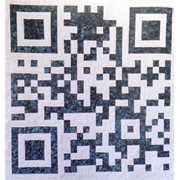Keeping track of warp and weft worked wonders for my quilt!
All the rows were absolutely painless to stitch together, since they were being sewn along the WEFT - the ever-so-slightly stretchy part of the fabric weave. I've never had rows go together so easily!
And there the joy began to fade...
Sandwiching this lap quilt, I damaged nerves in a couple of fingers, so I'm obviously doing something wrong there. But I dutifully did verticle, horizontal, and both diagonals, despite an e x t r e m e boredom with the process and a flaming desire to get AT it on the machine!
Came the day, I made myself attach the walking foot too. I don't know how you feel about the walking foot, but I absolutely hate using it. Nevertheless, reason prevailed over passion and I hooked it up. I had even used chalk lines to mark my diagonals! I've NEVER behaved myself so well!
That's when things went rapidly downhill.
The first thing that happened was that the walking foot snagged on every single basting line. Even when I lifted the foot to its maximum. So, so much for all that nerve-damaging basting: who knows what will hold and what will slip now?
The actual stitching was fine. Exactly on the points. But basically, I do three or four lines and I'm looking around for something else to do. It might be more fun if I could use an ordinary foot, but then layers would probably slip.
The simple fact is, sewing on a home machine simply isn't as much fun as I thought it was!
Over the years I've gotten used to hand-quilting, which, while slow, lets you fix small errors as you come up on them, is emotionally soothing, and your basting stays put.
This process was not soothing.
On to practising the free-motion part that was going to be in the blank squares of my Irish Chain quilt.
I dutifully made a small sandwich to practise on and pounced the chalk outline of the Scotch Thistle pattern.
Now, I don't do free-motion the way most people are instructed to... Leah Day on the web had a great tutorial that tells you to a) leave your feed dogs where they are, b) reduce the pressure on the presser foot, and c) turn the stitch length to 0.
It works wonderfully. A little bit of practise and I had gone all the way around my thistle. Perfectly. The tension was balanced (you have to make it around an 8 for free motion) and everything worked perfectly.
Except...
Except I don't have a stitch regulator on my home machine, so some of the stitches are small, and others are larger. Don't get me wrong - they're all "in the ballpark!" They're not radically different from each other...
I held my piece up to examine it at close range, and heaved a heavy sigh. Years of hand-quilting have spoiled me. I like my stitches to all be the same size!
I suddenly had an image of the meeting room where I used to attend our quilt guild, filled with familiar faces of people who love quilting. I remember talking about my machine quilting and how much fun it was, and especially trying to convince the ladies to try some free-motion quilting.
I clearly remember how their faces all became polite, blank masks, and I remember wondering what was wrong with these people that they couldn't get excited about this process!
Ahem. Now I know. They like all their stitches to be the same length. They don't like their laborious basting to get ripped out as they're sewing. In hand-quilting, you have absolute control. With a home machine that doesn't have a stitch regulator, it's simply not perfect.
Good enough - to be sure! Nothing the uninitiated would see, only quilters would see the problems!
But not perfect.
Sigh.
Saturday, May 26, 2018
Subscribe to:
Posts (Atom)





